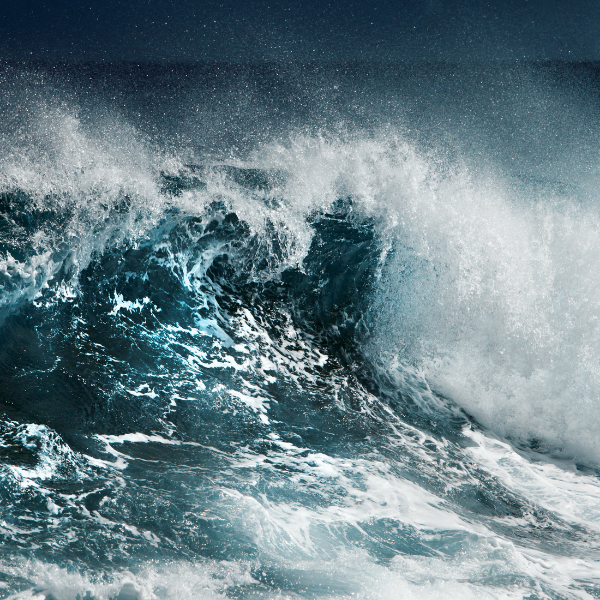WHAT CAUSES A ROGUE WAVE?
For centuries, sailors have reported seeing “freak waves”, “monster waves”, or “killer waves” out at sea. Many believed rogue waves had destroyed ships in open water. For example, Australian passenger and cargo steamship SS Waratah disappeared en route to Cape Town in 1909 with 211 people on board. At the time, experts thought the ship had been sunk by a large wave.
Yet, the existence of rogue waves hasn’t been acknowledged by the scientific community until a few decades ago, when they were defined as “extreme storm waves.”
WHAT IS A ROGUE WAVE?
Rogue waves are unusually large, unpredictable, and dangerous waves with steep sides and deep troughs. They often come from a direction that’s different from the prevailing wind and waves.
They can be as tall as 30 metres (nearly 100ft). Extreme storm waves are defined as waves at least 2.2 times higher than the significant wave height. This is the average of the highest third of waves, measured from the trough to the crest. The sea state can be fairly calm when a rogue wave strikes.
The first rogue wave ever observed happened in the North Sea, in 1984. It was an 11metre-tall (36ft) wave in a low sea state. However, scientists got more interested in the phenomenon in 1995, when a wave 25.6-metres (84ft) high was recorded in the same region.
Luckily, rogue waves aren’t common, so they’re not easy to study or measure accurately. It’s estimated that one in 10,000 waves is a rogue wave on average.
WHAT ARE THE TWO CAUSES OF ROGUE WAVES?
Scientists have concluded that there are two main causes behind extreme storm waves.
Constructive interference
Swells travel across the ocean at different speeds and in different directions. Sometimes, their crests, troughs, and lengths can match and strengthen each other. This generates a very large wave, which disintegrates quite fast. If two swells are travelling in the same direction though, the rogue wave that forms can last several minutes.
Focusing of wave energy
During a storm, some waves can form in a current that travels in the opposite direction of the wind and waves. When this happens, the wave frequency decreases and these waves blend together, forming a rogue wave. These extreme storm waves last longer than a few minutes.
Where do most rogue waves occur?
Scientists think that rogue waves occur most often in:
The Atlantic Ocean
South Africa
The Gulf Stream
The North Sea.
However, rogue waves can form anytime, anywhere, in the right conditions.
Extreme storm waves can also develop in freshwater. Experts think that the freighter SS Edmund Fitzgerald was sunk by a rogue wave during a storm in Lake Superior in 1975.
WHAT IS THE LARGEST ROGUE WAVE EVER RECORDED?
The tallest killer wave ever measured was the Ucluelet wave, which was observed in 2020 in British Columbia. It measured 17.6 metres (almost 58ft). However, some oceanographers and scientists claim the largest rogue wave ever observed was 30 metres (100ft) high.
According to researchers who have been studying rogue waves between 1994 and 2016, rogue waves are happening less often than before, but they are higher. The same scientists noticed that rogue waves tend to happen more often in the winter.
WHAT’S THE DIFFERENCE BETWEEN A ROGUE WAVE AND A TSUNAMI?
Waves, including rogue waves, are created by energy, such as wind, passing through the water. Tsunamis, on the other hand, are a series of extremely long waves generated by large and sudden displacements of the ocean - for example, an earthquake near the ocean floor.
A tsunami travels through the full depth of the ocean, while waves only affect the water surface. For this reason, tsunami waves travel further and faster than wind waves. The longer a wave travels, the bigger it becomes. So tsunami waves can grow a lot taller than wind waves.
While wind waves break near shore due to their short wavelengths, tsunami waves inundate low-lying land before going back to the ocean.
HOW DO YOU SURVIVE A ROGUE WAVE?
Here are some tips on how to tackle a large wave, whether it’s rogue or not.
Don’t turn broadside to the wave, head for one of the shoulders, where it’s shorter
Take the wave head-on, so you can’t capsize
Avoid cresting the backside of a large following wave - back off and let it roll away
Maintain speed when cresting the wave and keep the nose up to prevent broaching.
Now that you know all about rogue waves, you shouldn’t be too worried. Extreme storm waves aren’t very common in much of the world’s waters.
To avoid running into large waves in general, steer clear of headlands and reefs, where waves tend to break and the current meets shallower water.



